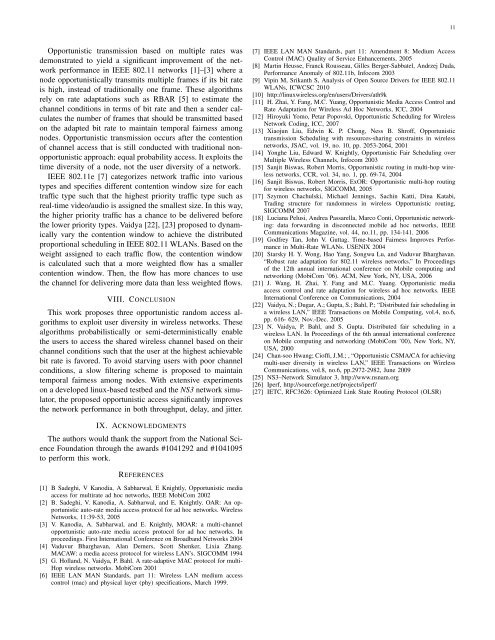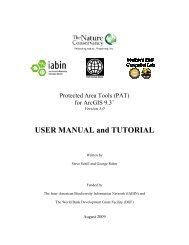Tech Report - University of Virginia
Tech Report - University of Virginia
Tech Report - University of Virginia
Create successful ePaper yourself
Turn your PDF publications into a flip-book with our unique Google optimized e-Paper software.
11Opportunistic transmission based on multiple rates wasdemonstrated to yield a significant improvement <strong>of</strong> the networkperformance in IEEE 802.11 networks [1]–[3] where anode opportunistically transmits multiple frames if its bit rateis high, instead <strong>of</strong> traditionally one frame. These algorithmsrely on rate adaptations such as RBAR [5] to estimate thechannel conditions in terms <strong>of</strong> bit rate and then a sender calculatesthe number <strong>of</strong> frames that should be transmitted basedon the adapted bit rate to maintain temporal fairness amongnodes. Opportunistic transmission occurs after the contention<strong>of</strong> channel access that is still conducted with traditional nonopportunisticapproach: equal probability access. It exploits thetime diversity <strong>of</strong> a node, not the user diversity <strong>of</strong> a network.IEEE 802.11e [7] categorizes network traffic into varioustypes and specifies different contention window size for eachtraffic type such that the highest priority traffic type such asreal-time video/audio is assigned the smallest size. In this way,the higher priority traffic has a chance to be delivered beforethe lower priority types. Vaidya [22], [23] proposed to dynamicallyvary the contention window to achieve the distributedproportional scheduling in IEEE 802.11 WLANs. Based on theweight assigned to each traffic flow, the contention windowis calculated such that a more weighted flow has a smallercontention window. Then, the flow has more chances to usethe channel for delivering more data than less weighted flows.VIII. CONCLUSIONThis work proposes three opportunistic random access algorithmsto exploit user diversity in wireless networks. Thesealgorithms probabilistically or semi-deterministically enablethe users to access the shared wireless channel based on theirchannel conditions such that the user at the highest achievablebit rate is favored. To avoid starving users with poor channelconditions, a slow filtering scheme is proposed to maintaintemporal fairness among nodes. With extensive experimentson a developed linux-based testbed and the NS3 network simulator,the proposed opportunistic access significantly improvesthe network performance in both throughput, delay, and jitter.[7] IEEE LAN MAN Standards, part 11: Amendment 8: Medium AccessControl (MAC) Quality <strong>of</strong> Service Enhancements, 2005[8] Martin Heusse, Franck Rousseau, Gilles Berger-Sabbatel, Andrzej Duda,Performance Anomaly <strong>of</strong> 802.11b, Infocom 2003[9] Vipin M, Srikanth S, Analysis <strong>of</strong> Open Source Drivers for IEEE 802.11WLANs, ICWCSC 2010[10] http://linuxwireless.org/en/users/Drivers/ath9k[11] H. Zhai, Y. Fang, M.C. Yuang, Opportunistic Media Access Control andRate Adaptation for Wireless Ad Hoc Networks, ICC, 2004[12] Hiroyuki Yomo, Petar Popovski, Opportunistic Scheduling for WirelessNetwork Coding, ICC, 2007[13] Xiaojun Liu, Edwin K. P. Chong, Ness B. Shr<strong>of</strong>f, Opportunistictransmission Scheduling with resources-sharing constraints in wirelessnetworks, JSAC, vol. 19, no. 10, pp. 2053-2064, 2001[14] Yonghe Liu, Edward W. Knightly, Opportunistic Fair Scheduling overMultiple Wireless Channels, Infocom 2003[15] Sanjit Biswas, Robert Morris, Opportunistic routing in multi-hop wirelessnetworks, CCR, vol. 34, no. 1, pp. 69-74, 2004[16] Sanjit Biswas, Robert Morris, ExOR: Opportunistic multi-hop routingfor wireless networks, SIGCOMM, 2005[17] Szymon Chachulski, Michael Jennings, Sachin Katti, Dina Katabi,Trading structure for randomness in wireless Opportunistic routing,SIGCOMM 2007[18] Luciana Pelusi, Andrea Passarella, Marco Conti, Opportunistic networking:data forwarding in disconnected mobile ad hoc networks, IEEECommunications Magazine, vol. 44, no.11, pp. 134-141. 2006[19] Godfrey Tan, John V. Guttag. Time-based Fairness Improves Performancein Multi-Rate WLANs. USENIX 2004[20] Starsky H. Y. Wong, Hao Yang, Songwu Lu, and Vaduvur Bharghavan.“Robust rate adaptation for 802.11 wireless networks.” In Proceedings<strong>of</strong> the 12th annual international conference on Mobile computing andnetworking (MobiCom ’06). ACM, New York, NY, USA, 2006[21] J. Wang, H. Zhai, Y. Fang and M.C. Yuang. Opportunistic mediaaccess control and rate adaptation for wireless ad hoc networks. IEEEInternational Conference on Communications, 2004[22] Vaidya, N.; Dugar, A.; Gupta, S.; Bahl, P.; “Distributed fair scheduling ina wireless LAN,” IEEE Transactions on Mobile Computing, vol.4, no.6,pp. 616- 629, Nov.-Dec. 2005[23] N. Vaidya, P. Bahl, and S. Gupta. Distributed fair scheduling in awireless LAN. In Proceedings <strong>of</strong> the 6th annual international conferenceon Mobile computing and networking (MobiCom ’00), New York, NY,USA, 2000[24] Chan-soo Hwang; Ci<strong>of</strong>fi, J.M.; , “Opportunistic CSMA/CA for achievingmulti-user diversity in wireless LAN,” IEEE Transactions on WirelessCommunications, vol.8, no.6, pp.2972-2982, June 2009[25] NS3–Network Simulator 3, http://www.nsnam.org[26] Iperf, http://sourceforge.net/projects/iperf/[27] IETC, RFC3626: Optimized Link State Routing Protocol (OLSR)IX. ACKNOWLEDGMENTSThe authors would thank the support from the National ScienceFoundation through the awards #1041292 and #1041095to perform this work.REFERENCES[1] B Sadeghi, V Kanodia, A Sabharwal, E Knightly, Opportunistic mediaaccess for multirate ad hoc networks, IEEE MobiCom 2002[2] B. Sadeghi, V. Kanodia, A. Sabharwal, and E. Knightly. OAR: An opportunisticauto-rate media access protocol for ad hoc networks. WirelessNetworks, 11:39-53, 2005[3] V. Kanodia, A. Sabharwal, and E. Knightly, MOAR: a multi-channelopportunistic auto-rate media access protocol for ad hoc networks. Inproceedings. First International Conference on Broadband Networks 2004[4] Vaduvur Bharghavan, Alan Demers, Scott Shenker, Lixia Zhang.MACAW: a media access protocol for wireless LAN’s. SIGCOMM 1994[5] G. Holland, N. Vaidya, P. Bahl. A rate-adaptive MAC protocol for multi-Hop wireless networks. MobiCom 2001[6] IEEE LAN MAN Standards, part 11: Wireless LAN medium accesscontrol (mac) and physical layer (phy) specifications, March 1999.
















